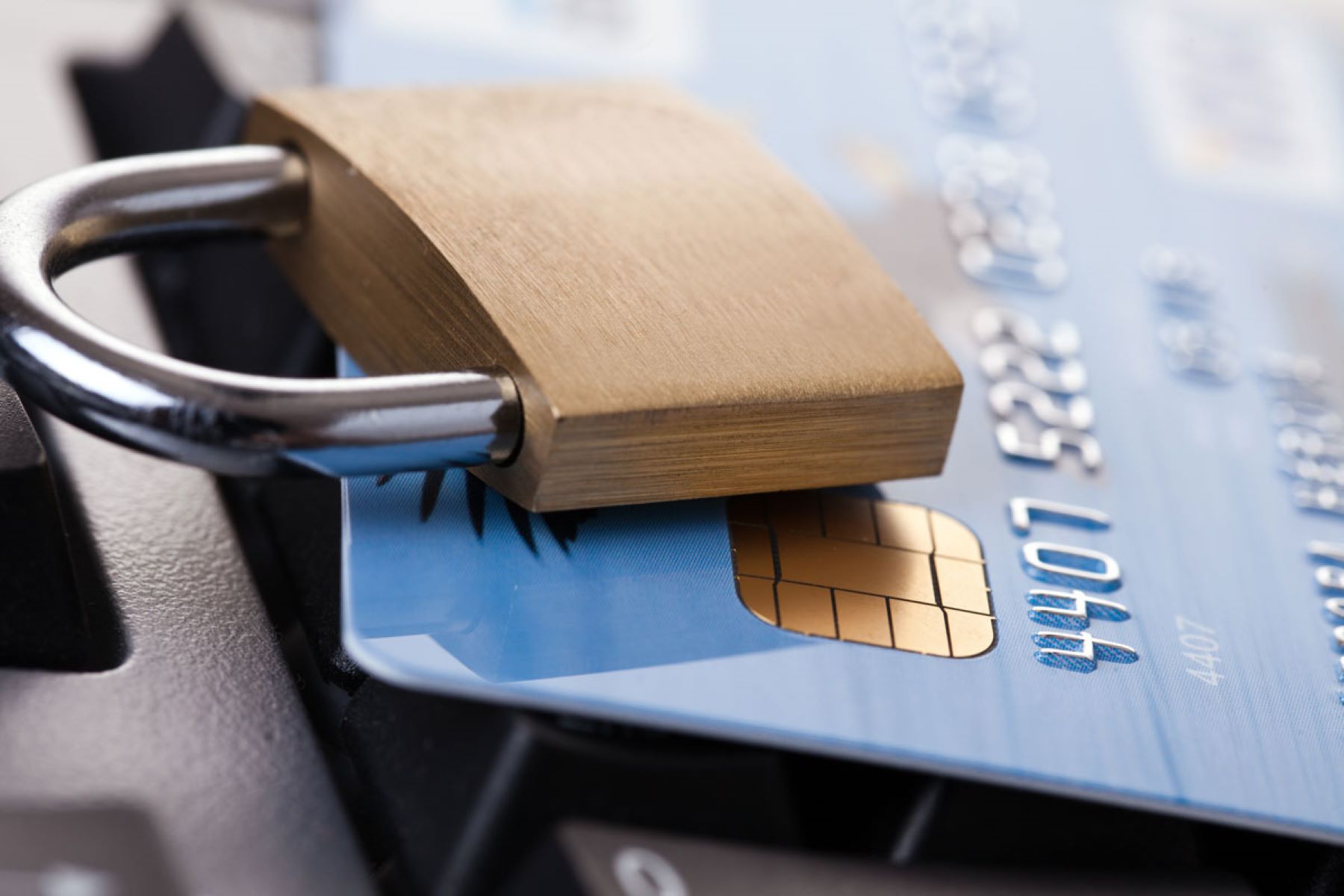Home>Finance>How To Securely Collect Credit Card Information


Finance
How To Securely Collect Credit Card Information
Modified: March 1, 2024
Learn how to securely collect credit card information in the finance industry to protect your customers' sensitive data. Implement proven strategies to ensure data security and build trust.
(Many of the links in this article redirect to a specific reviewed product. Your purchase of these products through affiliate links helps to generate commission for LiveWell, at no extra cost. Learn more)
Table of Contents
- Introduction
- Importance of Securely Collecting Credit Card Information
- Legal and Regulatory Compliance
- SSL Encryption and Secure Online Payment Gateways
- PCI DSS Compliance
- Secure Data Storage and Transmission Practices
- Implementation of Tokenization and Encryption Techniques
- Employee Training and Access Control
- Regular Security Audits and Penetration Testing
- Conclusion
Introduction
In today’s digital age, the collection and storage of sensitive financial information, such as credit card details, has become an integral part of many businesses. However, with the increased prevalence of data breaches and cyber attacks, it is more important than ever to securely collect credit card information to protect both the customers and the reputation of your organization.
Customers trust that their credit card information will be handled with the utmost care and security. It is your responsibility as a business owner or operator to ensure that their trust is well-placed. This article will provide you with valuable insights and best practices on how to securely collect credit card information, ensuring the privacy and safety of your customers’ sensitive data.
By following the recommended strategies and implementing robust security measures, you can protect your customers from various threats, including identity theft, fraud, and unauthorized access to their financial information.
As cybercriminals become more sophisticated, it is crucial to stay up-to-date with the latest security practices and comply with the relevant legal and regulatory requirements. This article will guide you through the essential steps to securely collect credit card information, providing you with the knowledge and tools necessary to safeguard your customers’ financial data.
Whether you are a small e-commerce website or a large multinational corporation, the principles outlined in this article apply to businesses of all sizes and industries. Investing in secure credit card data collection processes demonstrates your commitment to maintaining the trust of your customers and protecting their sensitive information.
Read on to discover the importance of securely collecting credit card information and the various strategies you can implement to effectively safeguard your customers’ data.
Importance of Securely Collecting Credit Card Information
Collecting credit card information is a sensitive process that requires utmost care and security. Ensuring the privacy and safety of customer data is not just good business practice; it is also a legal and ethical obligation. Let’s explore the importance of securely collecting credit card information:
1. Customer Trust: Trust is the foundation of any business relationship. When customers provide their credit card information, they expect it to be handled in a secure and confidential manner. Failing to protect their data can result in a loss of trust, leading to a damaged reputation and potential loss of business.
2. Legal Compliance: It is essential to comply with legal and regulatory requirements when collecting and storing credit card information. Depending on your location and the nature of your business, you may be subject to regulations such as the General Data Protection Regulation (GDPR) in the European Union or the Payment Card Industry Data Security Standard (PCI DSS) globally. Failing to meet these requirements can lead to severe penalties and legal consequences.
3. Protection Against Fraud: Securely collecting credit card information helps prevent fraud and unauthorized access to sensitive data. By implementing robust security measures, such as encryption and tokenization techniques, you can reduce the risk of data breaches and the likelihood of fraudulent activities.
4. Customer Retention: When customers feel confident that their credit card information is being collected and stored securely, they are more likely to continue doing business with you. Enhancing customer retention is crucial for the long-term success and growth of your business.
5. Brand Reputation: A data breach or security incident can damage your brand’s reputation, resulting in negative publicity and a loss of customer confidence. On the other hand, prioritizing security and implementing strong data protection measures can enhance your brand’s reputation as a trustworthy and reliable organization.
6. Compliance with Payment Industry Standards: If your business accepts credit card payments, compliance with payment industry standards, such as PCI DSS, is essential. Adhering to these standards ensures that your organization meets the necessary security requirements and reduces the risk of financial penalties and reputational damage.
7. Peace of Mind: Securely collecting credit card information provides peace of mind for both you and your customers. By implementing best practices and investing in robust security measures, you can significantly reduce the chances of a data breach and the resulting stress and financial consequences.
By recognizing the importance of securely collecting credit card information, you can take the necessary steps to protect your customers’ sensitive data, build trust, and maintain compliance with legal and industry standards. In the following sections, we will explore various strategies and best practices to ensure the secure collection and storage of credit card information.
Legal and Regulatory Compliance
When collecting credit card information, it is crucial to comply with legal and regulatory requirements to safeguard the privacy and security of customer data. Failure to meet these obligations can result in significant legal and financial consequences. Let’s explore the key aspects of legal and regulatory compliance:
1. General Data Protection Regulation (GDPR): If your business operates within the European Union or handles the personal data of EU citizens, you must comply with the GDPR. The GDPR imposes strict requirements for the collection, processing, and storage of personal information, including credit card details. It emphasizes the need for transparent data processing, explicit consent, and appropriate security measures to protect personal data.
2. Payment Card Industry Data Security Standard (PCI DSS): The PCI DSS is a globally recognized standard that applies to organizations that process, store, or transmit credit card information. It sets forth requirements for secure payment processing, network security, and protection of cardholder data. Compliance with PCI DSS is essential to ensure secure credit card transactions and protect against data breaches and fraud.
3. Data Privacy Regulations: In addition to the GDPR, many countries have enacted data privacy laws to protect the personal information of their citizens. Familiarize yourself with the privacy regulations applicable to your jurisdiction, such as the California Consumer Privacy Act (CCPA) or the Personal Information Protection and Electronic Documents Act (PIPEDA) in Canada. Ensure that your credit card data collection practices align with these regulations.
4. Data Breach Notification Laws: Many countries and states have implemented data breach notification laws that require businesses to inform affected individuals and authorities in the event of a data breach. Understand the requirements of these laws and have a comprehensive incident response plan in place to effectively and promptly mitigate the impacts of a breach.
5. Industry-Specific Regulations: Depending on your industry, there may be specific regulations governing the collection and storage of credit card information. For example, healthcare organizations must comply with the Health Insurance Portability and Accountability Act (HIPAA). Ensure that you are aware of and adhere to any industry-specific regulations that apply to your business.
6. Terms and Conditions: Clearly communicate your data collection and handling practices to customers through your website’s terms and conditions. Inform them about how their credit card information will be used, stored, and protected. Obtain explicit consent for collecting and processing their data and give them the option to review and update their information at any time.
Adhering to legal and regulatory requirements is essential for protecting the privacy of your customers’ credit card information and ensuring compliance with applicable laws. By understanding and following these regulations, you can demonstrate your commitment to data security and build trust with your customers. In the next sections, we will delve into technical measures and best practices for securely collecting and storing credit card information.
SSL Encryption and Secure Online Payment Gateways
When it comes to securely collecting credit card information, implementing SSL encryption and utilizing secure online payment gateways are crucial components. Let’s explore these important measures in more detail:
SSL Encryption: Secure Socket Layer (SSL) encryption is a standard security protocol that establishes an encrypted connection between a web server and a user’s browser. It ensures that communication and data transfer between these two points are encrypted and protected from eavesdropping or tampering. By obtaining an SSL certificate, you can encrypt all credit card information entered on your website, providing an added layer of security.
When a customer visits your website and sees the “https://” prefix in the URL and the padlock icon, they know that their connection is secure. This instills trust and confidence in your website and reassures customers that their credit card information is being transmitted safely.
Secure Online Payment Gateways: Utilizing a secure online payment gateway, such as PayPal, Stripe, or Authorize.Net, can further enhance the security of credit card transactions. These payment gateways act as a middleman between your website and the financial institutions, securely handling the transmission and processing of credit card information.
When a customer makes a purchase on your website, they are redirected to the payment gateway’s secure platform to enter their credit card details. The payment gateway encrypts this information, minimizing the exposure of sensitive data to your website. This significantly reduces the risk of data breaches and unauthorized access to credit card data.
Additionally, payment gateways often offer additional security features, such as fraud detection tools, address verification services (AVS), and 3D Secure authentication (e.g., Verified by Visa or Mastercard SecureCode). These features help detect and prevent fraudulent transactions, providing an extra layer of protection for both businesses and customers.
When selecting an online payment gateway, ensure that it complies with industry standards, such as PCI DSS, and has a solid reputation for security and reliability. Conduct thorough research and due diligence to choose a solution that aligns with your business needs and offers the necessary security measures.
By implementing SSL encryption and using secure online payment gateways, you can significantly enhance the security of credit card transactions on your website. These measures demonstrate your commitment to data protection and provide reassurance to customers that their sensitive information is being handled with the utmost care. In the next section, we will discuss the importance of PCI DSS compliance in securely collecting and storing credit card information.
PCI DSS Compliance
Ensuring PCI DSS (Payment Card Industry Data Security Standard) compliance is fundamental for securely collecting and storing credit card information. The PCI DSS is a set of security standards established by major credit card companies to protect cardholder data and prevent fraud. Let’s delve into the importance of PCI DSS compliance and its key requirements:
1. Protecting Cardholder Data: PCI DSS focuses on safeguarding sensitive credit card data through the implementation of secure processes, technologies, and best practices. Compliance ensures that data is securely collected, transmitted, and stored, reducing the risk of data breaches and unauthorized access.
2. Building a Secure Network: PCI DSS requires businesses to build a secure network infrastructure by implementing firewalls, restricting access to cardholder data, and regularly monitoring their networks for vulnerabilities. These measures protect against external threats and unauthorized access attempts.
3. Vulnerability Management: Regularly scan and address vulnerabilities in your systems to ensure they are secure and up to date. This includes implementing strong access control measures, regularly updating software, and applying security patches promptly.
4. Strong Access Control Measures: PCI DSS emphasizes the importance of restricting access to sensitive cardholder data. Implement strict user authentication, assign unique IDs to individuals, and provide access on a need-to-know basis. This helps prevent unauthorized access and internal data breaches.
5. Encryption and Tokenization: Protecting data in transit requires the use of secure encryption mechanisms. Implement strong encryption protocols to ensure that credit card information is transmitted securely. Additionally, tokenization can be used to replace cardholder data with randomly generated tokens, further reducing the risk of data exposure.
6. Regular Monitoring and Testing: Implement robust monitoring and logging mechanisms to detect any suspicious or unauthorized activities. Regularly test your security systems, conduct penetration testing, and respond promptly to any identified vulnerabilities or breaches.
7. Security Policies and Employee Awareness: Establish comprehensive security policies that address all aspects of PCI DSS compliance and communicate them to your employees. Regularly train your staff on security best practices and educate them about the importance of protecting cardholder data.
PCI DSS compliance is not a one-time effort but an ongoing process. It requires continuous monitoring, regular assessments, and proactive security practices. Non-compliance can lead to severe consequences, including financial penalties, loss of customers, reputational damage, and potential legal liabilities.
Working with PCI DSS compliant vendors, such as payment gateways and service providers, is crucial to ensure the security of credit card transactions. These vendors have already implemented the necessary security measures and can assist you in meeting PCI DSS requirements.
By achieving and maintaining PCI DSS compliance, you demonstrate your commitment to protecting cardholder data and building trust with your customers. In the next section, we will explore secure data storage and transmission practices to further enhance the security of credit card information.
Secure Data Storage and Transmission Practices
Securing credit card information not only involves safely collecting it but also ensuring secure data storage and transmission. Implementing robust practices in these areas is crucial to protect against data breaches and unauthorized access. Let’s explore the key considerations for secure data storage and transmission:
1. Data Encryption: Encrypting credit card data while storing it is essential for protecting sensitive information. Implement strong encryption algorithms to render the data unreadable to unauthorized individuals or malicious actors. Store encryption keys separately from the encrypted data to add an extra layer of security.
2. Tokenization: Implementing tokenization techniques can further enhance data security. Instead of storing actual credit card numbers, replace them with randomly generated tokens. This ensures that even if the token data is compromised, it cannot be used to retrieve the original credit card information.
3. Access Controls: Implement strict access controls to limit access to credit card data. Only provide access to authorized individuals who require it for legitimate business purposes. Use strong authentication methods, such as two-factor authentication, to prevent unauthorized access to stored data.
4. Data Retention Policies: Develop and enforce data retention policies to ensure that credit card information is not stored longer than necessary. Regularly review and purge old data to reduce the risk associated with storing sensitive information that is no longer required.
5. Secure File Transfer: When transmitting credit card information, ensure the use of secure protocols such as HTTPS or SFTP. These protocols encrypt the data during transmission, making it harder for attackers to intercept and access the sensitive information.
6. Payment Gateway Integration: Utilize secure payment gateways that handle credit card transactions securely and follow industry best practices for data storage and transmission. By leveraging their expertise, you can minimize the risk of data breaches and reduce the scope of your own data storage requirements.
7. Regular Data Backups: Implement regular data backup procedures to ensure that credit card data is not lost in case of system failures or other incidents. Store backups securely, following the same data protection practices as outlined above.
8. Incident Response Plan: Develop a comprehensive incident response plan that outlines the steps to be taken in the event of a data breach or security incident. Having a well-defined plan will help minimize the damage and efficiently address any breaches or vulnerabilities.
By implementing these secure data storage and transmission practices, you can significantly reduce the risk of breaches and unauthorized access to credit card information. These measures not only protect your customers but also help you maintain compliance with relevant data protection regulations.
However, it’s important to remember that security is an ongoing process. Regularly assess and update your security measures to adapt to emerging threats and vulnerabilities. In the next section, we will discuss tokenization and encryption techniques that can enhance data security further.
Implementation of Tokenization and Encryption Techniques
Tokenization and encryption are powerful techniques that can enhance the security of credit card data by rendering it unreadable or replacing it with random tokens. Implementing these techniques adds an extra layer of protection against data breaches and unauthorized access. Let’s delve into the details of tokenization and encryption:
Tokenization: Tokenization involves replacing sensitive credit card data, such as the primary account number (PAN), with randomly generated tokens. These tokens serve as surrogate values that have no correlation with the original credit card information. The tokens are stored in the system, while the actual credit card data is securely stored in a separate, highly secure environment.
Even if a hacker gains access to the tokenized credit card data, they will not be able to extract any meaningful or usable information. The tokens are useless outside of the system where they are generated, providing an effective way to protect sensitive data even in the event of a breach.
Tokenization offers significant benefits, including reducing the scope of PCI DSS compliance requirements. Since the actual credit card data is not stored, the risk associated with compromising sensitive information is minimized, and the burden of compliance is significantly reduced.
Encryption: Encryption is the process of transforming data into a non-readable format using cryptographic algorithms. Credit card data is encrypted during storage, transmission, and processing. Encryption ensures that even if the data is intercepted or accessed by unauthorized individuals, it remains unreadable and unusable.
There are two types of encryption commonly used for credit card data:
- At-Rest Encryption: This type of encryption ensures that credit card data is securely stored in databases, file systems, and other storage mediums. Encryption keys are used to encode the data, making it inaccessible without the proper decryption key.
- In-Transit Encryption: When credit card information is transmitted over networks, it is vulnerable to interception. Implementing secure protocols, such as HTTPS or SSL/TLS, encrypts the data during transmission, protecting it from being intercepted or tampered with.
Implementing a strong encryption framework is crucial to protect credit card data across all stages of its lifecycle. It ensures that the data remains secure, regardless of its location or how it is being processed.
Tokenization and encryption work hand in hand to provide a robust security framework for credit card data. Tokenization protects data at rest by substituting it with tokens, while encryption ensures the confidentiality and integrity of the data during transmission and storage.
When implementing tokenization and encryption techniques, it is important to adhere to industry standards and best practices. Choose proven encryption algorithms and secure tokenization methods to maintain the highest level of security.
By implementing these powerful techniques, you can greatly enhance the security of credit card data, protect against data breaches, and comply with industry regulations. In the next section, we will explore the significance of employee training and access control in maintaining secure credit card data handling practices.
Employee Training and Access Control
Employee training and access control play a crucial role in maintaining the security and confidentiality of credit card data. Ensuring that employees are well-trained and aware of their responsibilities helps prevent accidental data breaches and strengthens your overall security posture. Let’s explore the importance of employee training and access control in protecting credit card data:
1. Security Awareness Training: Conduct regular security awareness training sessions for all employees who handle credit card data. Educate them about the importance of data security, the risks associated with mishandling sensitive information, and the best practices for secure credit card data handling.
2. Handling Sensitive Information: Train employees on proper procedures for handling credit card data, including collecting, processing, and storing it securely. Emphasize the importance of secure data handling practices, such as not storing credit card information on personal devices or sharing it without proper authorization.
3. Password Hygiene: Educate employees on the importance of strong passwords and proper password management. Encourage the use of unique and complex passwords, regular password changes, and two-factor authentication to prevent unauthorized access to sensitive systems containing credit card data.
4. Phishing Awareness: Train employees to identify and report phishing attempts. Phishing attacks are often used to gain access to sensitive data, including credit card information. Educate employees about common phishing techniques and provide guidance on how to verify the authenticity of emails, links, and attachments.
5. Access Control: Implement a robust access control system to restrict access to credit card data based on least privilege principles. Only grant access to employees who require it for their job roles, and regularly review and revoke access for those who no longer need it. This helps minimize the risk of unauthorized access or accidental exposure of sensitive data.
6. Role-Based Access: Assign access privileges based on employees’ job roles and responsibilities. Limit access to credit card data to only those individuals who need it to perform their duties. This ensures that employees have access to the information necessary to fulfill their tasks without exposing the data to unnecessary risks.
7. Monitoring and Auditing: Implement monitoring and auditing systems to track and record activities related to credit card data. Regularly review activity logs to identify any suspicious or unauthorized access attempts. This provides an additional layer of security and helps in detecting and mitigating potential security incidents.
8. Incident Reporting: Establish clear procedures for reporting and responding to security incidents involving credit card data. Encourage employees to promptly report any potential breaches, suspicious activities, or policy violations so that appropriate actions can be taken to mitigate risks and protect data integrity.
By providing comprehensive training and ensuring effective access control measures, you empower employees to be proactive in protecting credit card data. Their awareness and adherence to security protocols significantly reduce the chance of data breaches and strengthen your overall data protection efforts.
Remember, security is a collective responsibility that involves everyone in your organization. By fostering a culture of security awareness and enforcing strict access control, you mitigate risks and ensure the secure handling of credit card data. In the next section, we will discuss the importance of regular security audits and penetration testing to maintain a high level of data security.
Regular Security Audits and Penetration Testing
Regular security audits and penetration testing are essential components of maintaining a high level of data security when it comes to handling credit card information. These proactive measures help identify vulnerabilities, assess existing security controls, and ensure that your systems and processes are adequately protected. Let’s explore the importance of regular security audits and penetration testing:
1. Identify Vulnerabilities: Security audits and penetration testing help identify potential vulnerabilities and weaknesses in your systems, processes, and infrastructure. By conducting comprehensive assessments, you can uncover any vulnerabilities or security gaps that may exist, allowing you to address them proactively.
2. Assess Security Controls: Regular audits and penetration testing enable you to assess the effectiveness of your security controls and measures. By evaluating the implementation of security policies, access controls, encryption, and other security mechanisms, you can identify areas for improvement and ensure that your systems are adequately protected.
3. Stay Ahead of Threats: The threat landscape is constantly evolving, with new and sophisticated attacks emerging regularly. Regular security audits and penetration testing help you stay ahead of potential threats by simulating real-world attack scenarios. By proactively testing your systems, you can identify vulnerabilities and implement appropriate countermeasures to mitigate the risk of data breaches.
4. Compliance with Standards and Regulations: Security audits and penetration testing assist in maintaining compliance with industry standards and regulations. By conducting regular assessments, you can ensure that your data security practices align with requirements such as PCI DSS, GDPR, and other relevant regulations. This helps you adhere to legal obligations and industry best practices.
5. Protect Customer Trust: Regular security audits and penetration testing demonstrate your commitment to data security, which helps build and maintain customer trust. By actively assessing and improving your security measures, you show that you value the privacy and confidentiality of your customers’ credit card information. This enhances your reputation and can positively impact customer loyalty.
6. Proactive Risk Management: Security audits and penetration testing enable you to proactively manage risks associated with credit card data handling. By identifying vulnerabilities and weaknesses in your systems, you can take appropriate actions to mitigate risks before they are exploited by malicious actors. This reduces the likelihood of data breaches, financial losses, and reputational damage to your organization.
7. Continual Improvement: Regular security audits and penetration testing provide insights and recommendations for improving your overall security posture. By implementing the recommendations from these assessments, you can continually enhance your data security practices and strengthen your defenses against potential threats.
It is essential to engage qualified security professionals to conduct thorough security audits and penetration testing. These experts possess the knowledge and expertise required to assess your systems objectively and identify potential vulnerabilities. They can provide valuable insights and recommendations to help strengthen your data security measures.
By regularly conducting security audits and penetration testing, you can identify vulnerabilities, improve security controls, and protect credit card data from potential breaches. These proactive measures are integral to maintaining a robust and resilient security posture. In the final section, we will conclude with a summary of the key points discussed in this article.
Conclusion
Securing credit card information is of paramount importance to protect both customers and businesses from the risks of data breaches and unauthorized access. By following the best practices and implementing robust security measures outlined in this article, you can ensure the safe and secure collection, storage, and transmission of credit card data.
We began by understanding the importance of securely collecting credit card information, emphasizing the need for customer trust, legal compliance, and protection against fraud. We then explored essential aspects such as SSL encryption and secure online payment gateways, which provide a secure environment for credit card transactions.
Compliance with legal and regulatory standards, such as GDPR and PCI DSS, is crucial for maintaining the privacy and security of credit card information. We discussed the significance of following these standards to protect against penalties, reputational damage, and legal liabilities.
Furthermore, we delved into secure data storage and transmission practices, highlighting the importance of encryption and tokenization techniques to safeguard credit card data. Proper implementation of these practices reduces the risk of data breaches and unauthorized access. We also emphasized the significance of employee training and access control, ensuring that all employees understand their responsibilities and adhere to secure data handling practices.
Regular security audits and penetration testing play a vital role in identifying vulnerabilities, assessing security controls, and staying ahead of potential threats. By actively monitoring and updating security measures, organizations can proactively manage risks and protect credit card data.
It is important to continually evaluate and improve your data protection strategies. By prioritizing security, complying with industry regulations, and implementing best practices, you can maintain customer trust, minimize the risk of data breaches, and protect your business’s reputation.
Remember, securing credit card information is an ongoing effort. Stay informed about the latest security trends and updates, and adapt your security measures accordingly. By prioritizing the protection of credit card data, you contribute to a safer digital ecosystem for both businesses and consumers.














